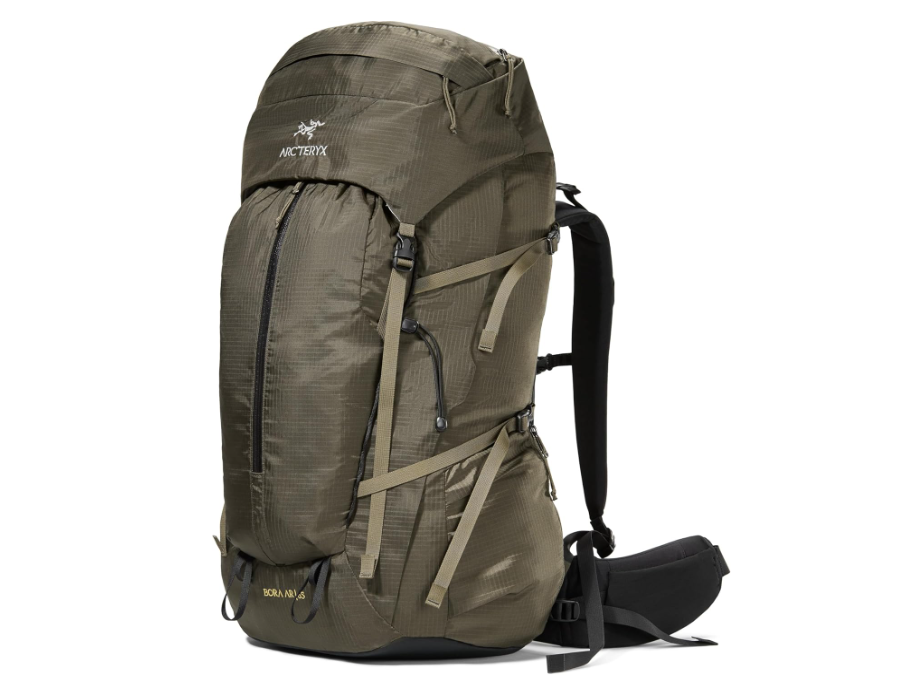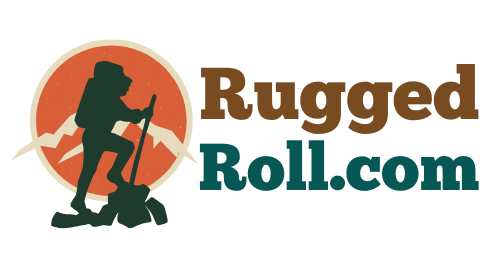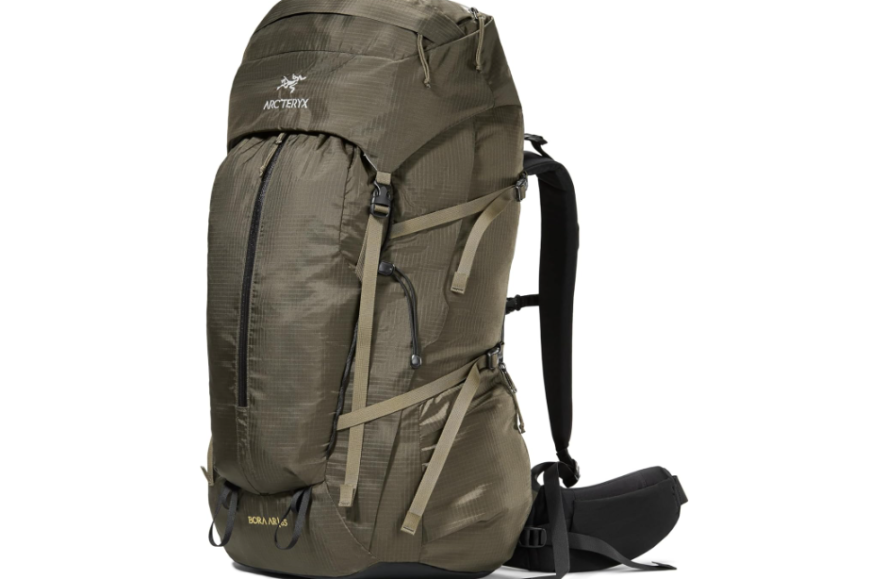Brief Overview
The Arc’teryx Bora 65 is a premium, feature-rich backpacking pack designed to provide uncompromising comfort, load-carrying capabilities, and adaptability for the committed outdoor enthusiast. As part of Arc’teryx’s renowned lineup of high-performance outdoor gear, the Bora 65 represents the brand’s commitment to engineering exceptional carrying solutions that cater to the needs of the most discerning backpackers.
Arc’teryx Bora 65

Specifications
Volume: 65 liters (3,967 cubic inches)
• Weight: 2.18 kg (4 lbs 13 oz)
• Dimensions: 79 x 38 x 32 cm (31 x 15 x 13 inches)
• Material: 420d and 630d nylon fabrics with custom RotoGlide hip belt
• Frame: Aluminum frame and load transfer disc
• Back Panel: Tegris® frame sheet with molded foam back panel
• Hip Belt: RotoGlide hip belt with 8 mm / 80 kg rated load transfer pivot
• Access: Top loading with side-zip access
• Pockets: Kangaroo pocket, two lid pockets, map pocket, two side pockets
• Hydration Compatible: Yes
• Additional Features: Top lid converts to a sling pack
• Suitable for: Extended backpacking trips, mountaineering expeditions
First Impressions
Unboxing the Arc’teryx Bora 65, the initial impression is one of impeccable craftsmanship and attention to detail. The backpack arrives neatly packaged, with all the components – including the removable top lid, compression straps, and hip belt – organized and easily accessible. This level of care and attention sets the stage for the exceptional design and quality that the Bora 65 embodies.
Upon first inspection, the Bora 65 reveals a sophisticated silhouette, with a range of functional features that hint at its advanced capabilities. The use of high-quality, durable materials, such as the rugged yet supple N410p-HT nylon fabric and the robust, precisely engineered suspension system, conveys a sense of confidence and reliability that is characteristic of the Arc’teryx brand.
What We Like
One of the standout features of the Arc’teryx Bora 65 is its exceptional comfort and load-carrying performance. The backpack’s innovative FuseForm Dual Construction suspension system, featuring a custom-molded, die-cut hipbelt and a ventilated, adjustable back panel, effectively distributes the weight and provides a remarkably stable and comfortable carrying experience, even when the pack is heavily loaded.
Key Strengths
- Exceptional Comfort: The custom-molded, die-cut hipbelt ensures a personalized fit.
- Innovative Suspension System: The FuseForm Dual Construction offers unparalleled load distribution.
- Comprehensive Organizational Features: Multiple pockets, including a large main compartment, dual side pockets, and a top lid pocket, enhance efficiency.
- Adjustability: Adjustable torso length, interchangeable hip belts, and removable components allow for a customized fit.
- Durable Construction: High-quality, technical fabrics and reinforced high-wear areas ensure long-term reliability.
What We Don’t
While the Arc’teryx Bora 65 is an exceptional backpacking pack that excels in many areas, there are a few aspects that may not appeal to all users.
Potential Drawbacks
- High Price Point: With an MSRP of $499, it may be a deterrent for budget-conscious outdoor enthusiasts.
- Larger Capacity: The substantial volume and weight may not be ideal for users who prefer a more compact carrying solution.
- Technical Design: Some users may find the advanced features and sophisticated design to be overly complex.
The Specs
Key Features
- Design: Top-loading backpack with FuseForm Dual Construction suspension system.
- Fit: Available in three torso size ranges (small, medium, and large).
- Materials: Durable N410p-HT nylon fabric with reinforced high-wear areas.
- Dimensions: 32 x 16 x 14 inches (81 x 41 x 36 cm) with a volume of 65 liters.
- Weight: 4 lbs 12 oz (2.15 kg) in the medium size.
- Convenient Features: Top-loading main compartment, front stash pocket, two side pockets, zippered hip belt pocket, integrated hydration sleeve, compression straps, removable top lid with additional storage space, and various attachment points for external gear.
Overall Performance
The Arc’teryx Bora 65 delivers exceptional performance, catering to the needs of the committed backpacker who demands uncompromising comfort, load-carrying capabilities, and adaptability. The backpack’s innovative FuseForm Dual Construction suspension system, featuring a custom-molded, die-cut hipbelt and a ventilated, adjustable back panel, effectively distributes the weight and provides a remarkably stable and comfortable carrying experience, even when the pack is heavily loaded.
Performance Highlights
- Innovative Suspension System: Ensures stable and comfortable carrying.
- Comprehensive Organizational Features: Keeps gear neatly organized and easily accessible.
- Advanced Features: Sophisticated design elements enhance functionality.
Overall Durability
The Arc’teryx Bora 65 is built to withstand the rigors of extended backcountry use, with a focus on long-term reliability and performance. The backpack’s high-quality materials, reinforced construction, and thoughtful design elements, such as the abrasion-resistant bottom and side panels, contribute to its overall longevity and ruggedness.
Durability Highlights
- High-Quality Materials: Ensure long-term reliability.
- Reinforced Construction: Enhances durability in high-wear areas.
- Thoughtful Design Elements: Contribute to overall ruggedness.
Adjustability
One of the standout features of the Arc’teryx Bora 65 is its exceptional level of adjustability and customization. The backpack’s adjustable torso length, interchangeable hip belts, and removable components (such as the lid and frame sheet) allow users to fine-tune the fit and functionality to suit their individual needs and preferences.
Adjustability Highlights
- Adjustable Torso Length: Ensures a personalized fit.
- Interchangeable Hip Belts: Allow for customization.
- Removable Components: Enhance versatility and adaptability.
Best Uses
Seasonal Use
The Arc’teryx Bora 65 is designed for reliable four-season performance, making it a suitable choice for spring, summer, fall, and even winter backpacking trips. The backpack’s durable construction, weather-resistant materials, and comprehensive feature set provide protection and functionality in a wide range of environmental conditions.
Environmental Use
The Bora 65’s versatile design and adjustable components make it a reliable choice for use in a variety of environments, from forested trails to exposed alpine settings. The backpack’s substantial carrying capacity and advanced features also render it a suitable option for extended backcountry expeditions, where a high-performance carrying solution is essential.
Comparison to Other Backpacks on the Market
When compared to other premium backpacking backpacks, the Arc’teryx Bora 65 stands out for its exceptional comfort, load-carrying capabilities, and overall attention to detail.
Competitor Analysis
- Osprey Aether Pro 70: While the Aether Pro 70 may offer a more accessible price point, the Bora 65’s innovative suspension system and superior comfort features make it a compelling alternative.
- Deuter Aircontact Pro 65+15: Known for its exceptional load-carrying capabilities, the Aircontact Pro 65+15 may offer a more budget-friendly price point, but the Bora 65’s premium materials and sophisticated design features make it a premium choice.
- Granite Gear Crown2 60: A popular value-oriented backpacking pack, the Crown2 60 offers cost savings, but the Bora 65’s advanced suspension system, higher level of adjustability, and comprehensive suite of organizational features make it a better choice for those who prioritize comfort and performance.
Our Final Thoughts
The Arc’teryx Bora 65 is a truly exceptional backpacking backpack that sets a new standard for comfort, load-carrying performance, and attention to detail. Designed for the committed outdoor enthusiast who demands the very best, this pack offers a meticulously engineered blend of advanced features, adjustability, and durable construction, making it a reliable and indispensable companion for the most demanding backcountry adventures.
Final Highlights
- Exceptional Comfort: Innovative suspension system and custom-molded hipbelt.
- Comprehensive Organizational Features: Multiple pockets and storage solutions.
- Durable Construction: High-quality materials and reinforced high-wear areas.
- High Degree of Adjustability: Ensures a personalized and optimized carrying experience.
FAQ
1. What makes the Arc’teryx Bora 65 stand out from other backpacks?
The Arc’teryx Bora 65 stands out due to its innovative FuseForm Dual Construction suspension system, exceptional comfort, comprehensive organizational features, and high degree of adjustability. These elements combine to create a backpack that offers unparalleled performance and reliability for committed outdoor enthusiasts.
2. Is the Arc’teryx Bora 65 suitable for all seasons?
Yes, the Arc’teryx Bora 65 is designed for reliable four-season performance. Its durable construction, weather-resistant materials, and comprehensive feature set make it suitable for spring, summer, fall, and even winter backpacking trips.
3. How does the Bora 65 compare to other premium backpacks like the Osprey Aether Pro 70?
While the Osprey Aether Pro 70 offers a more accessible price point and a comprehensive feature set, the Arc’teryx Bora 65’s innovative suspension system and superior comfort features make it a compelling alternative for those seeking the ultimate in backpacking performance.
4. What are the key materials used in the construction of the Bora 65?
The Bora 65’s main body is constructed from durable and abrasion-resistant N410p-HT nylon fabric, while the high-wear areas feature reinforced materials. The suspension components are made from high-quality, lightweight materials that prioritize both strength and comfort.
5. Can the Bora 65 be adjusted to fit different body types?
Yes, the Bora 65 offers a high degree of adjustability, including adjustable torso length, interchangeable hip belts, and removable components. This ensures a comfortable and personalized carrying experience for a wide range of body types and activity requirements.
![]()
















